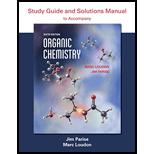
Concept explainers
(a)
Interpretation:
Whether
Concept introduction:
Nitration is a process in which an
(b)
Interpretation:
Whether
Concept introduction:
Nitration is a process in which an aromatic compound is nitrated by electrophilic substitution mechanism in presence of concentrated sulfuric acid and concentrated nitric acid. Electron donating groups substituted on the aromatic ring are those which donates electron to the aromatic ring. Electron donating groups are ortho and para-directing.
(c)
Interpretation:
Whether
Concept introduction:
Nitration is a process in which an aromatic compound is nitrated by electrophilic substitution mechanism in presence of concentrated sulfuric acid and concentrated nitric acid. Electron donating groups substituted on the aromatic ring are those which donates electron to the aromatic ring. Electron donating groups are ortho and para-directing.
Want to see the full answer?
Check out a sample textbook solution
Chapter 16 Solutions
Organic Chemistry Study Guide and Solutions
- How does methyl 2-acetoxybenzoate or Aspirin methyl ester hydrolise. Please show detailes.arrow_forward5 The compounds labeled benzophenone-3 (CH,O,) and benzophenone-5 (CHNAO,S) are found in certain sunscreens. Would you expect a sunscreen made with benzophenone-3 or benzophenone-5 to be more waterproof? Explain your choice.arrow_forwardKnow classification/mechanism of inhibition for: phenolics, halogens, oxidizers, heavy metals, surfactants (quaternary ammonium halide, soaps, detergents), alcohols, alkylating agents. Be able to give an example for each class of chemical.arrow_forward
- Write the therapeutic action of following on human body and mention the class of drugs to which each of the these belong:(i) Equanil(ii) Aspirin(iii) Chloramphenicolarrow_forward(a) Explain why an alkylamine is more basic than ammonia?(b) How would you convert(i) Aniline to nitrobenzene (ii) Aniline to iodobenzenearrow_forward6) If you are given a mixture consisting of following 3 compounds, explain how you would separate the components by solvent extraction method NH2 ÇOOH (A) Cyclopentylamine (B) 2,4-Cyclopentadiene-1-carboxylic acid (C) Benzenearrow_forward
- Which of the following reactions will synthesize phenol from benzene? 1) HNO3 + H2SO4; 2) Fe, HCl; 3) NaNO2, HCl, 0-10 oC; 4) warm H2SO4 and H2O 1) HNO3 + H2SO4; 2) Fe, HCl; 3) NaNO2, HCl, 0-10 oC; 4) CuCN; 5) dilute acid and heat 1) Acetyl chloride & AlCl3; 2) bleach 1) Ph-N2+ + KI; 2) BrMgCH=CH2 in ether, followed by H3O+; 3) warm, conc'd KMnO4 1) Cl-CH(CH3)-CH2CH2CH3 + FeBr3; 2) hot, conc'd KMnO4arrow_forwardHow are the following conversions carried out :(a) Aniline to p-hydroxyazobenzene(b) Ethanoyl chloride to Ethanenitrile.arrow_forwardDescribe how utlraviolet (UV) spectroscopy could distinguish propiophenone from 1-phenyl-2-propanone and p-ethylbenzaldehyde. Consider their respective wavelengths at their maximum UV absorbances, (λ max).arrow_forward
- A key step in the hydrolysis of acetamide in aqueous acid proceeds by nucleophilic addition of * OH (a) H3O* to CH3Ĉ NH2 (b) H2O to CH3ČNH2 + OH +OH (c) H3O* to CH,ČNH2 (d) HO¯ to CH3CNH2arrow_forwardMatching-Write the letter next to the correct structure. (A) N,N-dimethyl-2-butanamine (B) N-ethyl-N-methylpentanamine (C) N-isopropylpropylamine (D) diisopropylamine (E) 2-methylpropanamine (F) 2-butanamine (G) 2-methyl-2-propanamine (H) 4-methyl-1-hexanamine NH₂ H₂N NH2 ཙཾ། NH2 Narrow_forwardThe 1H- and 13C-NMR data of an ester of molecular formula C6H10O2 are given below. Also shown are the COSY and HETCOR NMR spectra of the ester. Draw the structure of the ester, explaining how you reach your conclusion. 1H-NMR: 7.20-6.90 (1H), 5.85 (1H), 4.16 (2H), 1.88 (3H), 1.31 (3H) ppm 13C-NMR: 166.7, 144.5, 123.0 , 60.2, 18.0, 14.3 ppmarrow_forward
 Organic ChemistryChemistryISBN:9781305580350Author:William H. Brown, Brent L. Iverson, Eric Anslyn, Christopher S. FootePublisher:Cengage Learning
Organic ChemistryChemistryISBN:9781305580350Author:William H. Brown, Brent L. Iverson, Eric Anslyn, Christopher S. FootePublisher:Cengage Learning Introduction to General, Organic and BiochemistryChemistryISBN:9781285869759Author:Frederick A. Bettelheim, William H. Brown, Mary K. Campbell, Shawn O. Farrell, Omar TorresPublisher:Cengage Learning
Introduction to General, Organic and BiochemistryChemistryISBN:9781285869759Author:Frederick A. Bettelheim, William H. Brown, Mary K. Campbell, Shawn O. Farrell, Omar TorresPublisher:Cengage Learning

